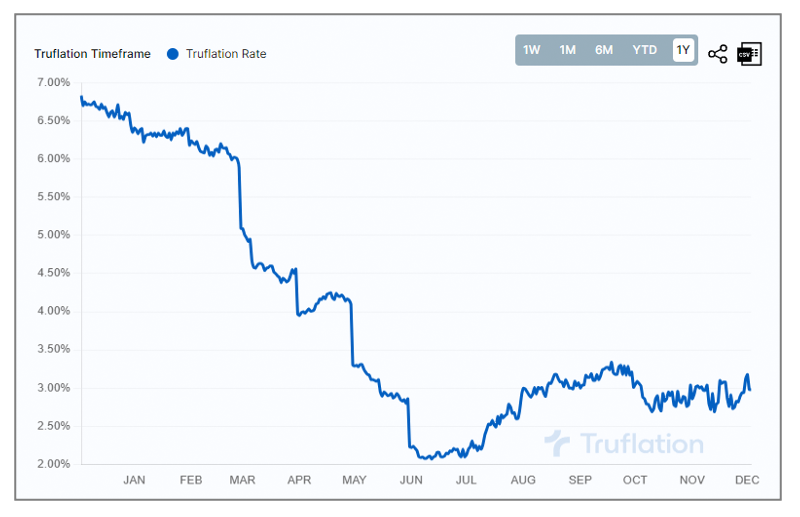
Dr. Patrick Welton Founder and Chief Investment Officer [email protected]
Our look ahead surrounds a viewpoint. We focus on strategic portfolio value. Where can Macro contribute the most? And how might this change in the year ahead? The engines are returns, noncorrelation, and downside performance. Each contributes in essential ways.
Looking forward, we are mindful that market predictions only contribute to stories. The disciplined work of preparing for strategic opportunities is what generates returns. And for all forthcoming opportunities, we know differences between failure and success are probabilities, not certainties. We see this unfold in markets every day. For that reason, we always believe in diversifying our approach to any theme and require ourselves to remain flexible to respond to rapid change.
New Landscape for 2024
Macro allocation opportunities consistently derive from two dominant sources – fundamental and strategic. As we enter 2024, I believe we are entering a new landscape offering both.
In late 2022 and early 2023, my prior outlook was cautious. The overwhelming global market drivers all appeared late stage. The waves of market response starting in 2020, first to the profound economic challenge of Covid and then the ubiquitous central bank’s reaction to surging inflation in 2022, created unidirectional markets from highly convex levels. The moves were large and displacing for many. Capital growth investors faced bear market declines and volatility worldwide. Even capital preservation investors were injured as five-year total returns in government bonds turned negative. Equity, currency, interest rate, and commodity moves of 20% to 40% were commonplace.
The specific aftermath of such rapid market shifts is always different, but the probable general path is always the same. Markets would likely reverse, consolidate, and recoil, especially after a significantly accelerated cycle on rates, the largest in 40 years, that impacted all assets. The questions were: when and for how long?
Though some markets started earlier, 2023 was a consolidating year with ranging reversals. The net market result is that by yearend, all dominant major asset moves released pressure, dropping their net positioning, and all asset classes exhibited wide-ranging consolidation, finding value levels. These are hallmarks of markets passing through their riskiest phases of uncertainty, which is why I believe this phase has largely passed.
My view ahead is that more is known today than unknown. And what comes next is far less likely to surprise markets, all of which have less embedded convexity. The primary phase of this rate cycle is over. Much of the refinancing impact and timing is known (but has not yet occurred). And public data recognition of inflation is beginning to reflect what high-frequency data has shown since June. US inflation rates are publicly converging (important for Fed credibility and political support) toward 2.5-3.0%. See the US Inflation Rate graphic below from Truflation.[1] Inflation rates in other major economies outside Japan are slightly higher but trending similarly. This has fundamentally set up multiple and more typical macro conditions for trading.

Normal Conditions Exist When Uncertainty Meets New Information
The drop and convergence of inflation levels set the stage for an unfolding policy conflict. These levels impute rising real rates without further Fed action. In the US, this level is ascending toward unequivocally restrictive rates. The restriction is even more forceful in economies where growth is lower. All things being equal, this fosters analyst declarations that higher for longer will be a sufficient lever for monetary control.
All things, of course, are rarely equal. They are also almost never static. Fiscal policy is driving increased borrowing levels into ranges far beyond GDP growth in multiple economies simultaneously at a time when debt service costs are soaring. These increased costs drive up future borrowing requirements, propelling further borrowing projections. The combined risks of bond auction strains with a floor rate of inflation stubbornly above a 2% target from labor force and deglobalization drivers are straining pillars of 2024 macro trends. How this ultimately resolves, at what rate, and where geographically will drive trends in rates, bonds, assets, currency, and commodity pricing.
It is easy to imagine a probable pathway to falling growth and inflation rapidly turning the rate cycle lower and sooner, creating a significant trend opportunity in rates not unlike 2014. However, it is equally easy to envision the eventual pricing impact of global fiscal borrowing colliding with a corporate refinancing wall, labor scarcity, surprising growth, and consumer resiliency, driving longer-term rates upward toward 6%. Both pathways normalize the yield curve. However, investor positioning is not equally ready for these potential outcomes. Resolving this policy conflict presents extensive macro alpha opportunities, whichever way they unfold.
These factors are also essential predicates to the next multi-year phase of fundamental macro conditions and their asset valuation effects. Growth, rates, term premiums, fiscal policies, savings rates, geographic differences, war, trade, and more will form the base for the next phase of equities, rates, bonds, currencies, and commodities. Macro and trend returns derive from the sum of sources. These are underlying economic drift (growth and demand), financial accrual (carry/term structure), information change (investor capital flows), and sentiment (self-feeding and accelerating markets) punctuated by events. Events probably should be spelled with a capital “E.” The events can be powerful accelerants or inflection points. Strategic portfolio value requires preparation for both.
Three Strategic Macro Allocation Implications for 2024
Risks and Opportunities Are Two-way
I believe that for the first time in many years, we enter the year with two-way risks and opportunities in almost every asset class. Zero-bound rates are gone and far from current levels. There are serious, bidirectional risks to rates with opposing resolutions at the short and long duration ends. Growth and demand are at levels that may rise or fall, triggering further policy reactions awaiting that input. Asset pricing and currency levels will trend accordingly. Correlation between equities and bonds may widely and routinely fluctuate after a decade of unilateral central bank support followed by two years of punishingly positive levels. Rates have also returned to where carry is meaningful in many asset classes and instruments after many years of drought. Term structure impact in commodities has risen to historically common and attractive levels after years of suppression. These are often associated with supply, demand, and storage challenges manifesting an array of alpha opportunities. Taken together, we enter 2024 with more typical conditions for Macro trading opportunities than the post-Global Financial Crisis decade from 2010 to 2019.
Events Can Ruin, Change, or Make a Year
Events are always a strategic consideration. Unfortunately, 2024 begins with a broad, potent base of potential market-moving events compared with most years. Event market reactions may be calm or explosive but are always critically sensitive to initial investor positioning.
In March of 2023, markets saw ten standard deviation moves in the US short-term treasury market – generally the most liquid market in the world. In February 2020, there were ten standard division moves in multiple asset markets from Covid. Or, more precisely, each was from investor-driven capital allocation flows accelerating in reaction to potential event impacts, pushing aside available liquidity. Every year, we witness events and investor reactions that drive portfolio risks to levels that should not statistically happen. Yet, the fact that they recur is one of the most reliable market phenomena.
Not much separates world markets today from serious event risks, even major risks investors have not priced in. We can attempt to stress test our portfolio preparation by imagining unfortunate possibilities. We can envision forthcoming failed treasury auctions, debt degrading, and self-inflicted reputational wounds in the wake of US Congressional budget deadlocks. Elections in the Netherlands and Slovakia may presage far more profound market-risk outcomes to forthcoming 2024 elections in the United States and Taiwan. Stalemates are among the most unstable risks that strive to be broken. Turning our scenario attention to the slow conflict progress in Ukraine, have investors imagined or prepared for a potential new wave of Russian aggression born of frustration to “protect” other Russian peoples under “threat”? It is all too probable to envision motivations to drive heavy forces toward Kaliningrad, Moldova, and Georgia to buttress internal patriotic support while draining Western resources in reaction. Or have investors prepared for the small but real potential that Hamas’ actions were a beginning designed to deplete Israeli resources and reserves awaiting a planned future move directly on its state by Iran and its proxies? I believe that markets are not remotely positioned for any of this. How might assets, energy, or commodities react? Rates and currencies? As sobering as these stresses are to plan for, the largest event risk is likely none of these potential scenarios. As I run through market history, I find the largest risks are almost always unforeseen, and thus, those for which investors were unprepared.
In parallel with changing fundamentals, I believe changing risks fuel one of the main engines of Macro’s strategic value. If a Macro manager is too rigid to flex with changing events, they may miss the most valuable opportunities to help their investors. If an investor cannot answer the question of what in their portfolio may benefit from significant inflections in risks, they have actionable strategic improvements to make. Harnessing risks into returns is a material part of Macro’s noncorrelation, downside performance, and overall long-term allocation value.
Financing – Headwind or Tailwind
Financing matters again. Businesses and active asset management strategies that are net borrowers, especially with leverage, are climbing a wall of costs. In contrast, businesses and asset strategies with excess cash can look forward to a vertical lift of forward return expectations.
Financing at these levels has important opportunity implications for where investors allocate in the capital structure, with what liquidity, at what leverage, and in which active strategies. For many sector investments, equivalent forward returns may be achievable with a contractual claim on returns high in the capital structure at far less risk than holding common equity. In the realm of alternatives, hedge fund allocators will need to recalibrate expectations. Some highly leveraged strategies may see available alpha decline 50% or more if current rate structures persist, depleting their net alpha after borrowing while carrying the additional risk of rate sensitivity. Other strategies may naturally increase income, undiminished return expectations, and may profit from rate changes and other risks. Systematic Macro and Managed Futures, for instance, like many cash-rich strategies is currently earning 500 bp per year of added return above trading profits compared with less than 100 bp per year over the past decade.
Views and Philosophy
Returning to our viewpoint, I believe the biggest levers for long-term returns and resiliency are strategic. Thoughtful and recurrent practices matter most. Therefore, for most investors, I do not think any specific observation in these Macro perspectives speaks to any need for quick action. But for some, they may.
Match horizons
I believe published investor effectiveness data aligns well with my lived market experience. A key strategic practice for investors is matching their investment horizon holding power to the investment’s natural return horizon. For some transient opportunities, this may be wholly opportunistic. For many long-term developing assets, this may best be decades. I believe diversified Macro’s most effective horizon view is closer to 5-7 years. Shorter is noisily below the resolution of macroeconomic environments and their market follow-through. Much longer also works well for evaluation but then generally assesses a concatenation of business and macro cycle evolutions. Lastly, I find strategic allocation design for events the easiest. Events, especially the most impactful ones, are unpredictable and unfold too rapidly. The key strategic action is preparation. Reacting is too late.
Diversify Equally for Knowns and Unknowns
In resilient portfolios, diverse allocations harvest returns and cover risks over wide-ranging market conditions. Management is then a matter of affirming or balancing relative allocation size. And though it is a highly imperfect science to weigh the degree of forward opportunities and risks, perfection is not required to be effective. Diversification helps across a wide range of levels. Because I believe 2024 brings more typical base conditions and sources for Macro performance, I would target an average Macro allocation for any given investor’s design. I think the most prominent economic elements are known to the market. And I expect the incremental market reactions to be more of a net trading and trend opportunity source, as two-way alpha opportunities exist in so many asset classes.
But what about events? Because the event risk horizon is profoundly high, certainly higher than most years, it may speak to larger or more protective Macro allocations. But weighing against this judgment is the reality that the impact of a sentinel event in any year is unpredictable, even if large. I think the best each investor can do is objectively survey their primary portfolio’s asset composition and assess vulnerability to adverse, severe market events. The results will be investors’ most salient decision input to adjust allocations.
More at Better Value
Lastly, I advocate for investor-driven rebalancing policies if a portfolio is well-designed. I have witnessed many of our investors gather materially more returns with this discipline. In some cases, millions more in returns. The rebalancing drives a high probability of allocator-driven alpha by providing more allocation mass at better value levels while harvesting some returns from the temporarily over-valued.
Dr. Patrick Welton, Founder and CIO
Welton Investment Partners
[1] Source: 12/4/23, https://truflation.com/#US%20Inflation%20Rate.
+ + +
THE OPINIONS EXPRESSED ARE THOSE OF THE AUTHOR OR THE INDIVIDUAL TO WHOM THE STATEMENTS ARE ATTRIBUTED. WHILE BELIEVED TO BE REASONABLY BASED ON FACT AND INQUIRY, THERE CAN BE NO GUARANTEES THAT SUCH OUTCOMES EXPRESSED OR IMPLIED HAVE OCCURRED OR WILL INDEED OCCUR.
CERTAIN INFORMATION CONTAINED HEREIN CONSTITUTES “FORWARD-LOOKING STATEMENTS,” WHICH CAN BE IDENTIFIED BY THE USE OF FORWARD-LOOKING TERMINOLOGY SUCH AS “MAY,” “WILL,” “SHOULD,” “EXPECT,” “ANTICIPATE,” “PROJECT,” “ESTIMATE,” “INTEND,” “CONTINUE,” OR “BELIEVE,” OR THE NEGATIVES THEREOF OR OTHER VARIATIONS THEREON OR COMPARABLE TERMINOLOGY. DUE TO VARIOUS RISKS AND UNCERTAINTIES, ACTUAL EVENTS, RESULTS OR ACTUAL PERFORMANCE MAY DIFFER MATERIALLY FROM THOSE REFLECTED OR CONTEMPLATED IN SUCH FORWARD-LOOKING STATEMENTS. NOTHING CONTAINED HEREIN MAY BE RELIED UPON AS A GUARANTEE, PROMISE, ASSURANCE, OR REPRESENTATION AS TO THE FUTURE.
THIS DOCUMENT IS NOT A SOLICITATION FOR INVESTMENT. SUCH INVESTMENT IS ONLY OFFERED ON THE BASIS OF INFORMATION AND REPRESENTATIONS MADE IN THE APPROPRIATE OFFERING DOCUMENTATION. ANY INVESTMENT PROGRAM DESCRIBED HEREIN IS SPECULATIVE, INVOLVES SUBSTANTIAL RISK AND IS NOT SUITABLE FOR ALL INVESTORS. NO REPRESENTATION IS BEING MADE THAT ANY INVESTOR WILL OR IS LIKELY TO ACHIEVE SIMILAR RESULTS.
PAST PERFORMANCE IS NOT NECESSARILY INDICATIVE OF FUTURE RESULTS.
